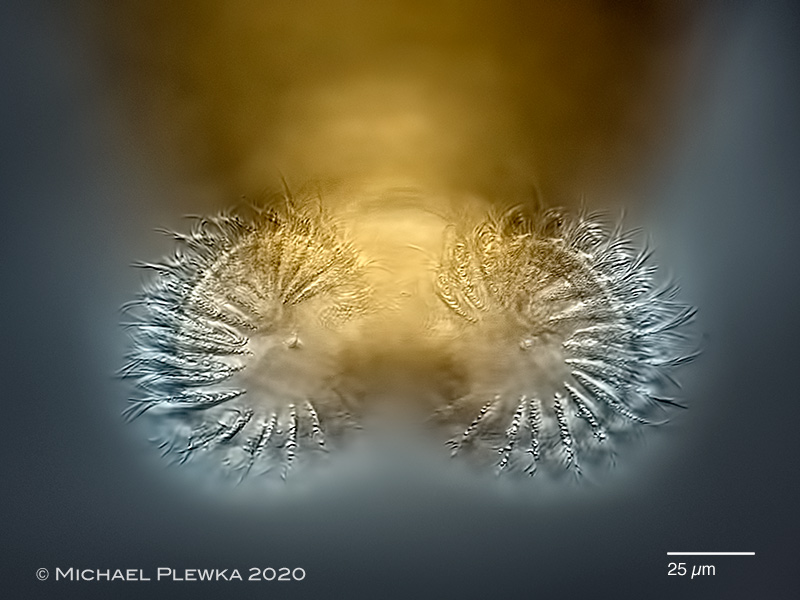 |
| Mniobia magna; frontal view |
It is of course rather banal to point out that the name of the "wheel animalcules" is derived from the "wheel-like" appearance of their front part. Although I have been dealing with this creatures for quite some time now, there are still certain phenomena that are fascinating for me, and there are also some which I still don't really understand. The readers of this should also know that the rotifers do not really turn anything, so this perception is an optical illusion.
In the bdelloid rotifers in focus here there are in principle 3 groups of cilia on the columns at the front:
Here illustrated by an image of Didymodactylos carnosus, a quite common rotifer,
which occurs in moss: |
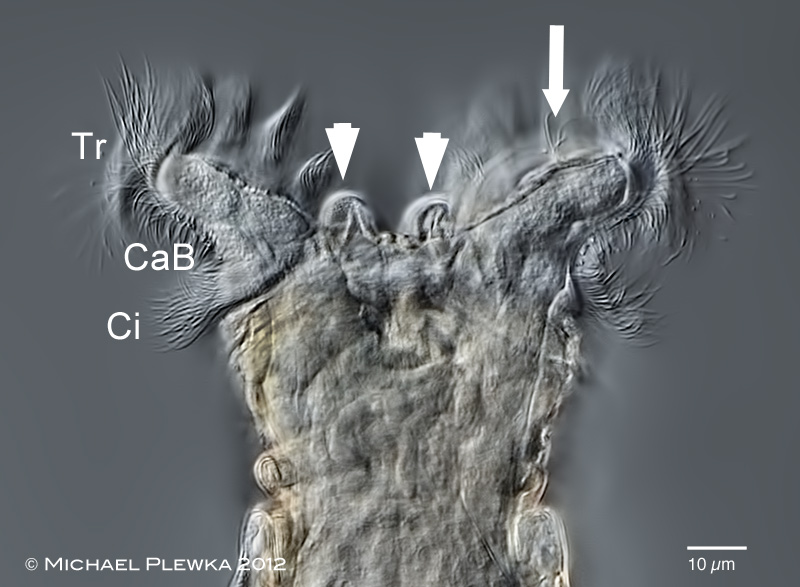 |
| 1. In the very front there is a wreath of long cilia, the so-called trochus (Tr)
2. posterior to the trochus is a field of short cilia, which extend posteriorly to the pharynx (circumapical band (CaB)).
3. behind it is another wreath of long cilia, which is incomplete (cingulum, Ci).
|
| |
The axis of the "rotation" of the apparent rotational metachronal movement of the trochal cilia is parallel to the longitudinal axis of the body; the apparent rotational metachronal movement is therefore perpendicular to it. How do these cilia move? One could now assume that the cilia also move in the direction of "rotation". However, this is not the case, but rather the cilia move (more or less) perpendicular to it, i.e. (more or less) parallel to the longitudinal axis of the body (double arrow).
This can be seen here with the rotifer Rotaria macrura. The double arrow marks the movement of the cilia; the arrowhead labelled "ES" marks the direction of the effective stroke; the arrowhead labelled "RS" marks the direction of the return stroke. The curved arrows indicate the direction of the metachronal movement: |
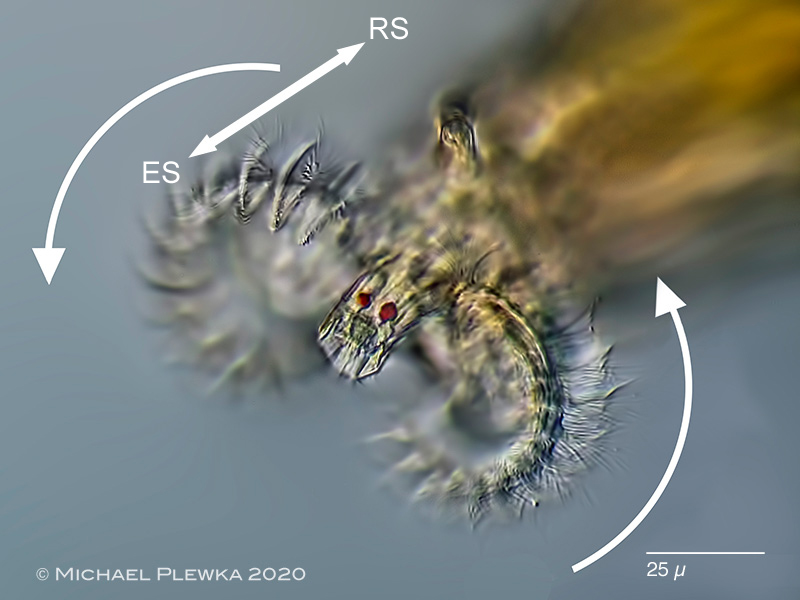 |
| |
| In relation to the direction of the movement of the metachronal wave the direction of the effective stroke of the cilia is therefore to the right. This is called dexioplectic metachronal movement (which is known also from ciliates). All bdelloid rotifers of the group Philodinida (this excludes Philodinavidae and Adinetidae) seem to show dexioplectic movement, and thus the direction of the metachronal movement is always counter-clockwise. The zoologist Zelinka has already shown this counter-clockwise movement in the following drawing (1893) for one of the trochal disks (which can be seen here frontally): |
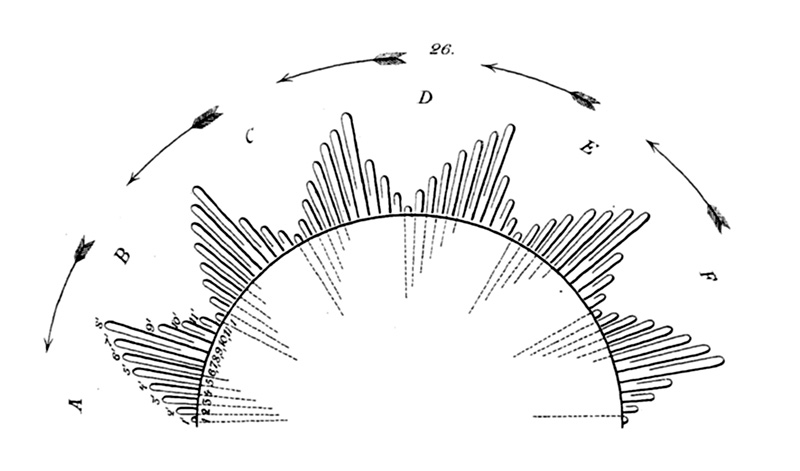 |
| |
| Zelinka also provided the template for the next figure, which visualizes the water flow caused by the cilia movement of the bdelloid rotifer Mniobia symbiotica. The water flow was made visible in the preparation by carmine granules (shown here in carmine red). The turquoise arrows mark the direction of flow: |
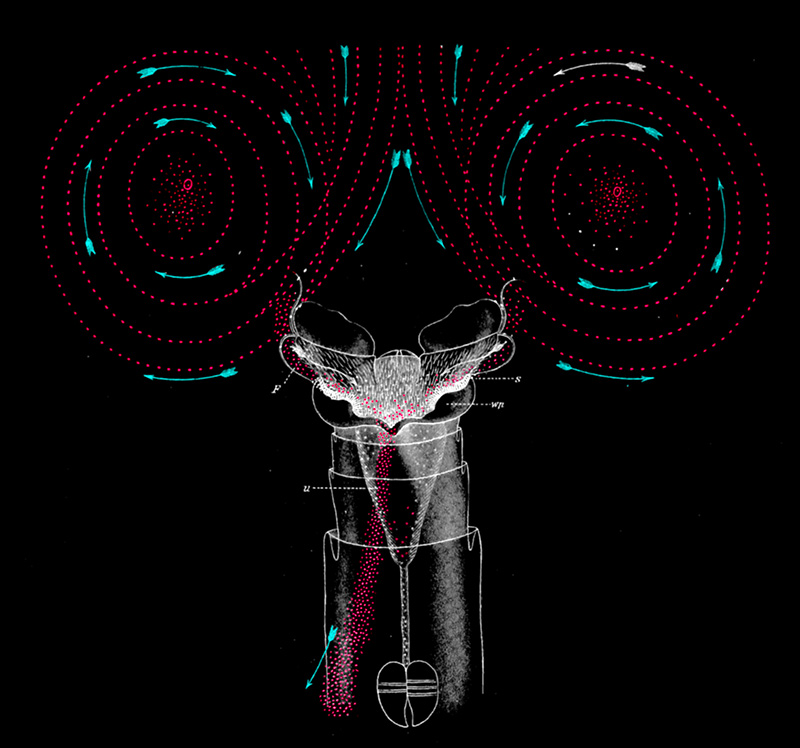 |
| I admit that although I have been using a microscope for quite a long time and have seen the aquatic rotifers like Rotaria rotatoria or Rotaria macrura at least hundreds of times, I have only now become aware of some findings or questions (which I could have come up with earlier).
Considering the dominance of our mechanistic world view it is obvious to assume that these "gears" of the bdelloid rotifers would behave like two interlocking gears, i.e. they would move in opposite directions. Often we assume that when an object appears symmetrical, parts that exist in pairs are mirror-symmetrical to each other. Also in two- or four-engined propeller airplanes, half of the propellers rotate in the opposite direction to the others.
The turquoise arrows in the picture above suggest such a symmetry. Also the trochal cilia (with an inclination of ≈ ±30 degrees from the longitudinal axis) suggest this symmetry.
But this is not so. The apparent direction of movement of the cilia runs in the same direction for both trochi. So the "direction of rotation" is asymmetrical. Zelinka investigated this at that time on the rotifer Mniobia symbiotica (which lives in the lobules of the liverwort Frullania dilatata). I could observe another Mniobia-species (Mniobia magna), which is often found in dry moss, which is watered before. These animals are then quite greedy for food and are not disturbed by the light of the microscope and vibrations. Furthermore their body is often in vertical position when they are whirling, so that in this moment the plane of the trochi is in focus. The following image shows the trochal discs of Mniobia magna in frontal view (somewhat in an angle of 45 degrees on the ventral side):
|
| Based on the above findings, of course, further questions arise immediately:
1. in which direction do the "wheels" of other (bdelloid) rotifers seem to run?
2. can the trochal cilia of (not only bdelloid) rotifers also work the other way around?
As can be seen from Zelinka's drawing above, the trochal cilia movement Mniobia is always such that the impression of a counter-clockwise rotation is created when looking at the critters from the front. I have not observed any other "direction of rotation" in bdelloid rotifers of the taxon Philodinida.
Nowadays there is of course the possibility to document the direction of rotation on video. But for this you have to be aware that with these rotary movements, even if they are only apparent, the Shannon's sampling theorem has to be taken into account. We know this from old Western films where the carriage moves to the right, but the wheels turn counterclockwise because the frame rate of the film camera does not capture the rotation frequency of the wheels accurately enough (aliasing). My first attempts with a DSLR with 30 fps resulted in a fottage which showed the reverse direction of what I could see live. So at least the "sampling frequenxy of 30 fps is too low. I have recorded some videos for documentation purposes with 180 fps (Panasonic GH5), later 300 fps (Panasonic GH6), it seems to work there.
Still images taken with a flash of approx. 100µs result in images with groups of cilia apperaring roughly "C-shaped" like this:
|
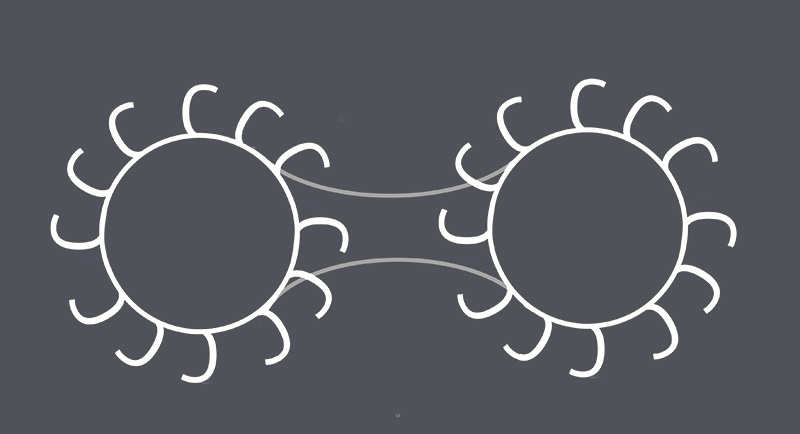 |
| ... and not like this: |
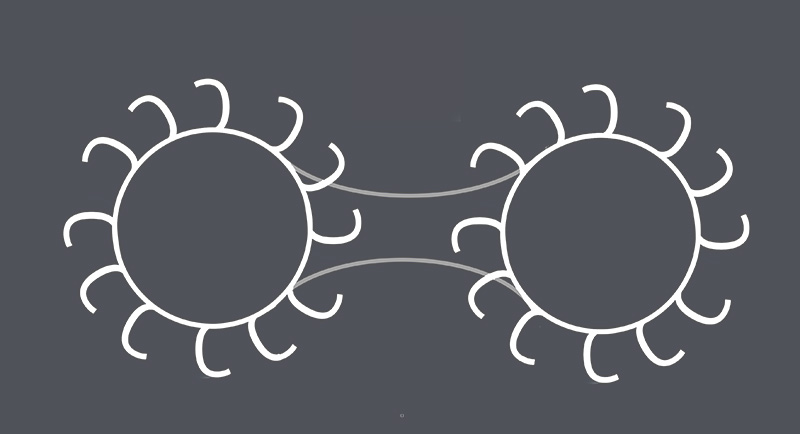 |
| The reason for this is that during the time of the recovery stroke the cilia are bent and move in a 3-dimensional curve (resulting in a "C"), whereas during the faster effective stroke the cilia are linea and move 2-dimensional. |
| |
| The question about the asymmetry of the direction of the trochal cilia movements can be extended to other groups of organisms: how does the "rotational movement" behave for example in the other group of monogonont rotifers, like Floscularia, Filinia, Hexarthra, to name a few examples of species with a distinct corona. So here is an interesting example of a corona from Conochilus hippocrepis:. |
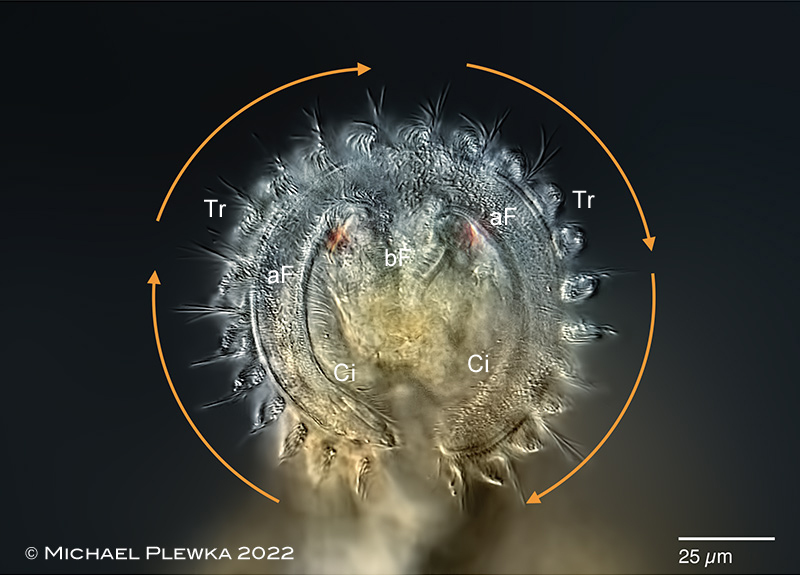 |
| |
If one assumes that the corona of the Conochilus species is derived the corona of the Flosculariaceae, then the different apparent direction of rotation of the trochal cilia can be explained by the displacement of the mouth from the ventral to the dorsal side. However, this is only a partial aspect: another special feature of Conochilus is the swimming direction, which is quasi backwards, i.e. the rear end (the foot) is in front when swimming (arrow). The reason for this is the direction of the effective stroke of the trochal cilia, which is forward (arrowhead), in contrast to the effective stroke of bdelloid rotifers: |
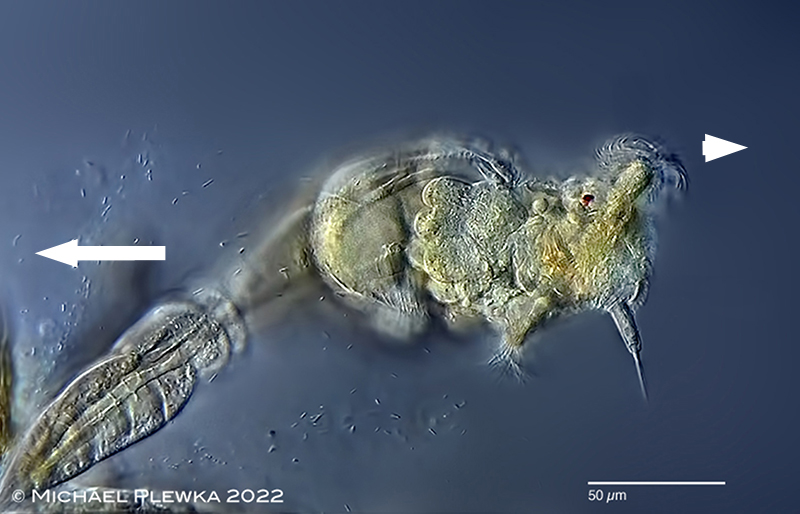 |
| From these two directions of movement it follows that the metachronal movement of the trochal cilia is also dexioplectic and thus does not differ from that of the bdelloid (Philodinida) or flosculariid (Gnesiotrocha) rotifers. |
| |
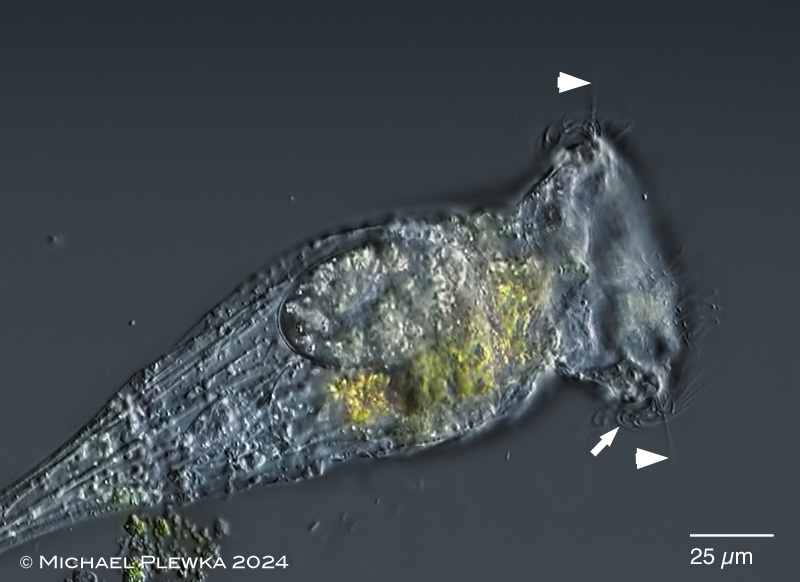 |
| From a phylogenetic perspective, the head of Collotheca appears to be something special within the rotifers, and this may also be reflected in the direction in which the cilia strike. Collotheca pelagica with its non-sessile lifestyle is something special in this group, and the cilia are possibly also used for locomotion. The effective stroke of the cilia is directed forwards (arrowhead), as in Conochilus. This can also be conluded from the recovery stroke when the cilia are curved (arrow). Unfortunately, a metachronous movement of these cilia could not yet been observed or documented up to now. |
| |
| |
|
|
|
| |